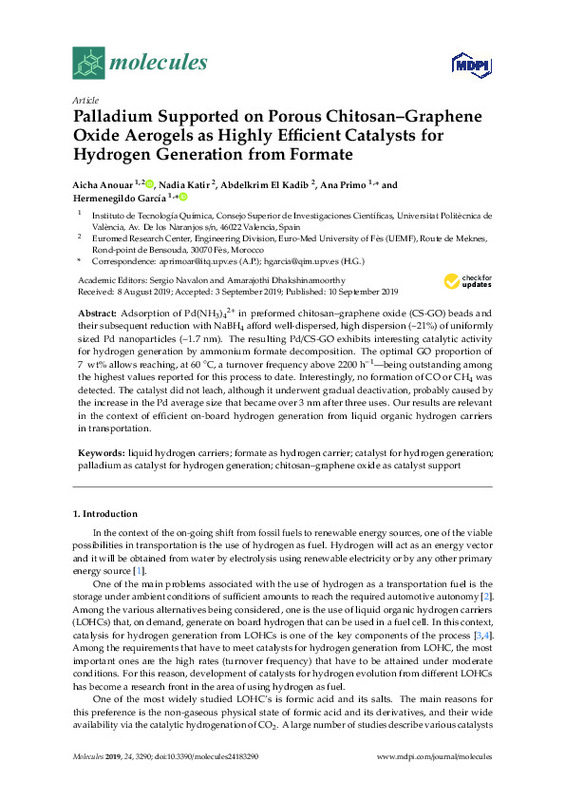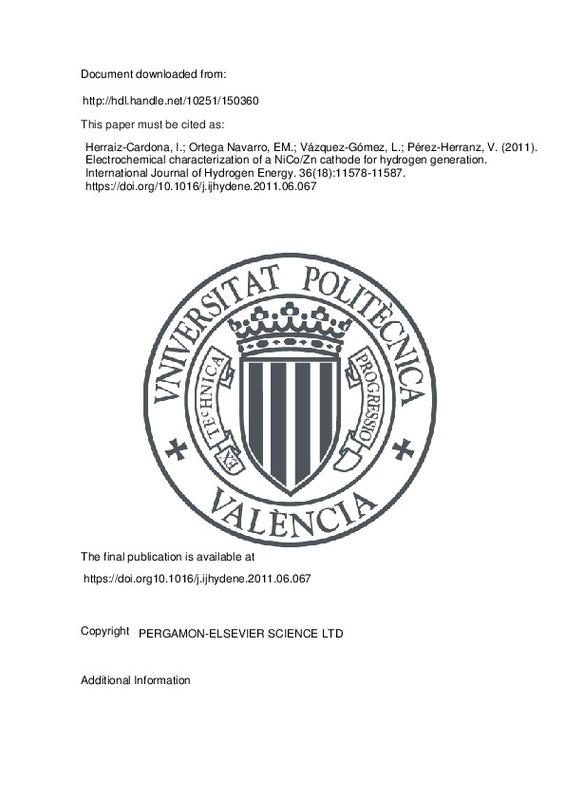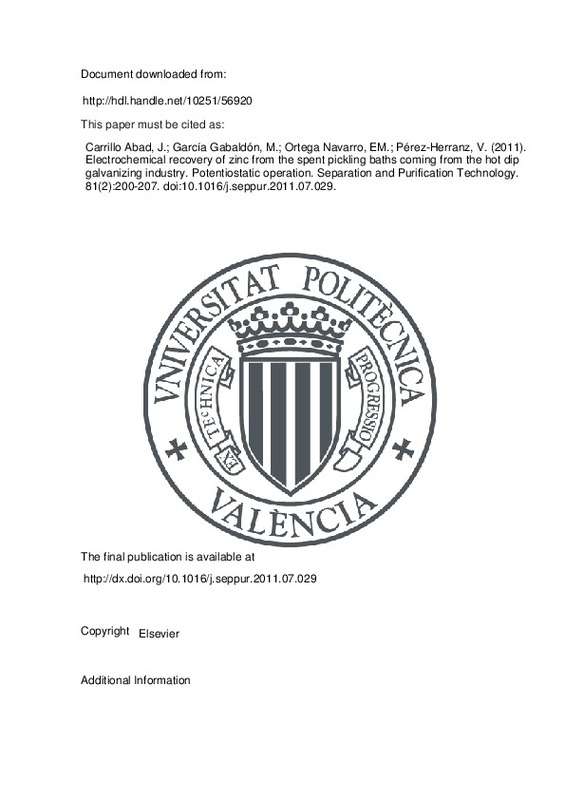JavaScript is disabled for your browser. Some features of this site may not work without it.
Buscar en RiuNet
Listar
Mi cuenta
Estadísticas
Ayuda RiuNet
Admin. UPV
Palladium Supported on Porous Chitosan-Graphene Oxide Aerogels as Highly Efficient Catalysts for Hydrogen Generation from Formate
Mostrar el registro sencillo del ítem
Ficheros en el ítem
| dc.contributor.author | Anouar, Aicha
|
es_ES |
| dc.contributor.author | Katir, Nadia
|
es_ES |
| dc.contributor.author | El Kadib, Abdelkrim
|
es_ES |
| dc.contributor.author | Primo Arnau, Ana Maria
|
es_ES |
| dc.contributor.author | García Gómez, Hermenegildo
|
es_ES |
| dc.date.accessioned | 2021-01-21T04:32:12Z | |
| dc.date.available | 2021-01-21T04:32:12Z | |
| dc.date.issued | 2019-09 | es_ES |
| dc.identifier.issn | 1420-3049 | es_ES |
| dc.identifier.uri | http://hdl.handle.net/10251/159612 | |
| dc.description.abstract | [EN] Adsorption of Pd(NH3)(4)(2+) in preformed chitosan-graphene oxide (CS-GO) beads and their subsequent reduction with NaBH4 afford well-dispersed, high dispersion (similar to 21%) of uniformly sized Pd nanoparticles (similar to 1.7 nm). The resulting Pd/CS-GO exhibits interesting catalytic activity for hydrogen generation by ammonium formate decomposition. The optimal GO proportion of 7 wt% allows reaching, at 60 degrees C, a turnover frequency above 2200 h(-1)-being outstanding among the highest values reported for this process to date. Interestingly, no formation of CO or CH4 was detected. The catalyst did not leach, although it underwent gradual deactivation, probably caused by the increase in the Pd average size that became over 3 nm after three uses. Our results are relevant in the context of efficient on-board hydrogen generation from liquid organic hydrogen carriers in transportation. | es_ES |
| dc.description.sponsorship | This research was funded by the Spanish Ministry of Science, Innovation and Universities (Grant RTI2018-098237-B-C21 and Severo Ochoa). A.P. also thanks the Spanish Ministry of Science and Education a research associate Ramon y Cajal contract. A.A. thanks UEMF for scholarship. | es_ES |
| dc.language | Inglés | es_ES |
| dc.publisher | MDPI AG | es_ES |
| dc.relation.ispartof | Molecules | es_ES |
| dc.rights | Reconocimiento (by) | es_ES |
| dc.subject | Liquid hydrogen carriers | es_ES |
| dc.subject | Formate as hydrogen carrier | es_ES |
| dc.subject | Catalyst for hydrogen generation | es_ES |
| dc.subject | Palladium as catalyst for hydrogen generation | es_ES |
| dc.subject | Chitosan-graphene oxide as catalyst support | es_ES |
| dc.subject.classification | QUIMICA ORGANICA | es_ES |
| dc.title | Palladium Supported on Porous Chitosan-Graphene Oxide Aerogels as Highly Efficient Catalysts for Hydrogen Generation from Formate | es_ES |
| dc.type | Artículo | es_ES |
| dc.identifier.doi | 10.3390/molecules24183290 | es_ES |
| dc.relation.projectID | info:eu-repo/grantAgreement/AEI/Plan Estatal de Investigación Científica y Técnica y de Innovación 2017-2020/RTI2018-098237-B-C21/ES/HETEROUNIONES DE GRAFENO CON CONFIGURACION CONTROLADA. SINTESIS Y APLICACIONES COMO SOPORTE EN CATALISIS Y EN ELECTRODOS/ | es_ES |
| dc.rights.accessRights | Abierto | es_ES |
| dc.contributor.affiliation | Universitat Politècnica de València. Instituto Universitario Mixto de Tecnología Química - Institut Universitari Mixt de Tecnologia Química | es_ES |
| dc.contributor.affiliation | Universitat Politècnica de València. Departamento de Química - Departament de Química | es_ES |
| dc.description.bibliographicCitation | Anouar, A.; Katir, N.; El Kadib, A.; Primo Arnau, AM.; García Gómez, H. (2019). Palladium Supported on Porous Chitosan-Graphene Oxide Aerogels as Highly Efficient Catalysts for Hydrogen Generation from Formate. Molecules. 24(18):1-13. https://doi.org/10.3390/molecules24183290 | es_ES |
| dc.description.accrualMethod | S | es_ES |
| dc.relation.publisherversion | https://doi.org/10.3390/molecules24183290 | es_ES |
| dc.description.upvformatpinicio | 1 | es_ES |
| dc.description.upvformatpfin | 13 | es_ES |
| dc.type.version | info:eu-repo/semantics/publishedVersion | es_ES |
| dc.description.volume | 24 | es_ES |
| dc.description.issue | 18 | es_ES |
| dc.identifier.pmid | 31509955 | es_ES |
| dc.identifier.pmcid | PMC6767305 | es_ES |
| dc.relation.pasarela | S\393685 | es_ES |
| dc.contributor.funder | Agencia Estatal de Investigación | es_ES |
| dc.contributor.funder | Ministerio de Ciencia y Tecnología | es_ES |
| dc.contributor.funder | Université Euro Méditerranéenne de Fès | es_ES |
| dc.contributor.funder | Ministerio de Ciencia, Innovación y Universidades | es_ES |
| dc.description.references | Staffell, I., Scamman, D., Velazquez Abad, A., Balcombe, P., Dodds, P. E., Ekins, P., … Ward, K. R. (2019). The role of hydrogen and fuel cells in the global energy system. Energy & Environmental Science, 12(2), 463-491. doi:10.1039/c8ee01157e | es_ES |
| dc.description.references | Modisha, P. M., Ouma, C. N. M., Garidzirai, R., Wasserscheid, P., & Bessarabov, D. (2019). The Prospect of Hydrogen Storage Using Liquid Organic Hydrogen Carriers. Energy & Fuels, 33(4), 2778-2796. doi:10.1021/acs.energyfuels.9b00296 | es_ES |
| dc.description.references | Sotoodeh, F., & Smith, K. J. (2013). An overview of the kinetics and catalysis of hydrogen storage on organic liquids. The Canadian Journal of Chemical Engineering, 91(9), 1477-1490. doi:10.1002/cjce.21871 | es_ES |
| dc.description.references | Zhong, H., Iguchi, M., Chatterjee, M., Himeda, Y., Xu, Q., & Kawanami, H. (2018). Formic Acid‐Based Liquid Organic Hydrogen Carrier System with Heterogeneous Catalysts. Advanced Sustainable Systems, 2(2), 1700161. doi:10.1002/adsu.201700161 | es_ES |
| dc.description.references | Li, S., Zhou, Y., Kang, X., Liu, D., Gu, L., Zhang, Q., … Jiang, Q. (2019). A Simple and Effective Principle for a Rational Design of Heterogeneous Catalysts for Dehydrogenation of Formic Acid. Advanced Materials, 31(15), 1806781. doi:10.1002/adma.201806781 | es_ES |
| dc.description.references | Boddien, A., Mellmann, D., Gärtner, F., Jackstell, R., Junge, H., Dyson, P. J., … Beller, M. (2011). Efficient Dehydrogenation of Formic Acid Using an Iron Catalyst. Science, 333(6050), 1733-1736. doi:10.1126/science.1206613 | es_ES |
| dc.description.references | Akbayrak, S., Tonbul, Y., & Özkar, S. (2017). Nanoceria supported palladium(0) nanoparticles: Superb catalyst in dehydrogenation of formic acid at room temperature. Applied Catalysis B: Environmental, 206, 384-392. doi:10.1016/j.apcatb.2017.01.063 | es_ES |
| dc.description.references | Bi, Q.-Y., Lin, J.-D., Liu, Y.-M., He, H.-Y., Huang, F.-Q., & Cao, Y. (2016). Dehydrogenation of Formic Acid at Room Temperature: Boosting Palladium Nanoparticle Efficiency by Coupling with Pyridinic-Nitrogen-Doped Carbon. Angewandte Chemie, 128(39), 12028-12032. doi:10.1002/ange.201605961 | es_ES |
| dc.description.references | Li, Z., Yang, X., Tsumori, N., Liu, Z., Himeda, Y., Autrey, T., & Xu, Q. (2017). Tandem Nitrogen Functionalization of Porous Carbon: Toward Immobilizing Highly Active Palladium Nanoclusters for Dehydrogenation of Formic Acid. ACS Catalysis, 7(4), 2720-2724. doi:10.1021/acscatal.7b00053 | es_ES |
| dc.description.references | Kandile, N. G., Zaky, H. T., Mohamed, M. I., Nasr, A. S., & Ali, Y. G. (2018). Extraction and Characterization of Chitosan from Shrimp Shells. Open Journal of Organic Polymer Materials, 08(03), 33-42. doi:10.4236/ojopm.2018.83003 | es_ES |
| dc.description.references | Molnár, Á. (2019). The use of chitosan-based metal catalysts in organic transformations. Coordination Chemistry Reviews, 388, 126-171. doi:10.1016/j.ccr.2019.02.018 | es_ES |
| dc.description.references | Guibal, E. (2005). Heterogeneous catalysis on chitosan-based materials: a review. Progress in Polymer Science, 30(1), 71-109. doi:10.1016/j.progpolymsci.2004.12.001 | es_ES |
| dc.description.references | El Kadib, A., Primo, A., Molvinger, K., Bousmina, M., & Brunel, D. (2011). Nanosized Vanadium, Tungsten and Molybdenum Oxide Clusters Grown in Porous Chitosan Microspheres as Promising Hybrid Materials for Selective Alcohol Oxidation. Chemistry – A European Journal, 17(28), 7940-7946. doi:10.1002/chem.201003740 | es_ES |
| dc.description.references | Barskiy, D. A., Kovtunov, K. V., Primo, A., Corma, A., Kaptein, R., & Koptyug, I. V. (2012). Selective Hydrogenation of 1,3-Butadiene and 1-Butyne over a Rh/Chitosan Catalyst Investigated by using Parahydrogen-Induced Polarization. ChemCatChem, 4(12), 2031-2035. doi:10.1002/cctc.201200414 | es_ES |
| dc.description.references | Frindy, S., Primo, A., Lahcini, M., Bousmina, M., Garcia, H., & El Kadib, A. (2015). Pd embedded in chitosan microspheres as tunable soft-materials for Sonogashira cross-coupling in water–ethanol mixture. Green Chemistry, 17(3), 1893-1898. doi:10.1039/c4gc02175d | es_ES |
| dc.description.references | Primo, A., & Quignard, F. (2010). Chitosan as efficient porous support for dispersion of highly active gold nanoparticles: design of hybrid catalyst for carbon–carbon bond formation. Chemical Communications, 46(30), 5593. doi:10.1039/c0cc01137a | es_ES |
| dc.description.references | Chtchigrovsky, M., Primo, A., Gonzalez, P., Molvinger, K., Robitzer, M., Quignard, F., & Taran, F. (2009). Functionalized Chitosan as a Green, Recyclable, Biopolymer-Supported Catalyst for the [3+2] Huisgen Cycloaddition. Angewandte Chemie International Edition, 48(32), 5916-5920. doi:10.1002/anie.200901309 | es_ES |
| dc.description.references | Primo, A., Liebel, M., & Quignard, F. (2009). Palladium Coordination Biopolymer: A Versatile Access to Highly Porous Dispersed Catalyst for Suzuki Reaction. Chemistry of Materials, 21(4), 621-627. doi:10.1021/cm8020337 | es_ES |
| dc.description.references | El Kadib, A. (2014). Chitosan as a Sustainable Organocatalyst: A Concise Overview. ChemSusChem, 8(2), 217-244. doi:10.1002/cssc.201402718 | es_ES |
| dc.description.references | Bratskaya, S., Privar, Y., Nesterov, D., Modin, E., Kodess, M., Slobodyuk, A., … Pestov, A. (2019). Chitosan Gels and Cryogels Cross-Linked with Diglycidyl Ethers of Ethylene Glycol and Polyethylene Glycol in Acidic Media. Biomacromolecules, 20(4), 1635-1643. doi:10.1021/acs.biomac.8b01817 | es_ES |
| dc.description.references | Kadib, A. E., Bousmina, M., & Brunel, D. (2014). Recent Progress in Chitosan Bio-Based Soft Nanomaterials. Journal of Nanoscience and Nanotechnology, 14(1), 308-331. doi:10.1166/jnn.2014.9012 | es_ES |
| dc.description.references | Frindy, S., Primo, A., Ennajih, H., el kacem Qaiss, A., Bouhfid, R., Lahcini, M., … El Kadib, A. (2017). Chitosan–graphene oxide films and CO 2 -dried porous aerogel microspheres: Interfacial interplay and stability. Carbohydrate Polymers, 167, 297-305. doi:10.1016/j.carbpol.2017.03.034 | es_ES |
| dc.description.references | Valentin, R., Molvinger, K., Quignard, F., & Brunel, D. (2003). Supercritical CO2 dried chitosan: an efficient intrinsic heterogeneous catalyst in fine chemistry. New Journal of Chemistry, 27(12), 1690. doi:10.1039/b310109f | es_ES |
| dc.description.references | Huang, T., Shao, Y., Zhang, Q., Deng, Y., Liang, Z., Guo, F., … Wang, Y. (2019). Chitosan-Cross-Linked Graphene Oxide/Carboxymethyl Cellulose Aerogel Globules with High Structure Stability in Liquid and Extremely High Adsorption Ability. ACS Sustainable Chemistry & Engineering, 7(9), 8775-8788. doi:10.1021/acssuschemeng.9b00691 | es_ES |
| dc.description.references | Kolanthai, E., Sindu, P. A., Khajuria, D. K., Veerla, S. C., Kuppuswamy, D., Catalani, L. H., & Mahapatra, D. R. (2018). Graphene Oxide—A Tool for the Preparation of Chemically Crosslinking Free Alginate–Chitosan–Collagen Scaffolds for Bone Tissue Engineering. ACS Applied Materials & Interfaces, 10(15), 12441-12452. doi:10.1021/acsami.8b00699 | es_ES |
| dc.description.references | Dobrovolná, Z., & Červený, L. (2000). Ammonium formate decomposition using palladium catalyst. Research on Chemical Intermediates, 26(5), 489-497. doi:10.1163/156856700x00480 | es_ES |
| dc.description.references | Han, D., & Yan, L. (2013). Supramolecular Hydrogel of Chitosan in the Presence of Graphene Oxide Nanosheets as 2D Cross-Linkers. ACS Sustainable Chemistry & Engineering, 2(2), 296-300. doi:10.1021/sc400352a | es_ES |
| dc.description.references | Wang, J., Tan, H., Jiang, D., & Zhou, K. (2017). Enhancing H2 evolution by optimizing H adatom combination and desorption over Pd nanocatalyst. Nano Energy, 33, 410-417. doi:10.1016/j.nanoen.2017.02.001 | es_ES |











